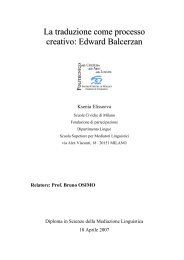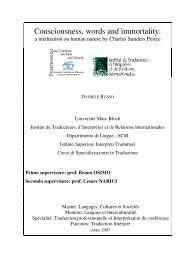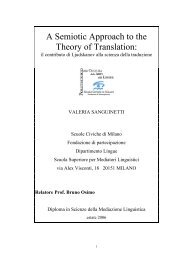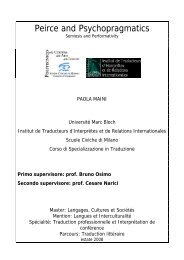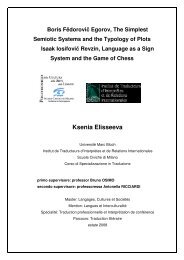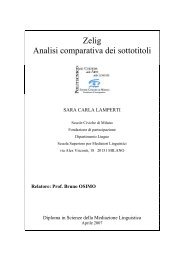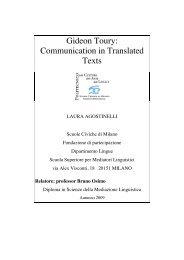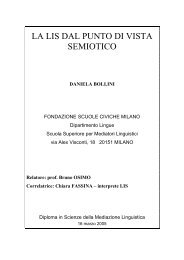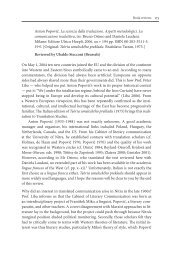Relatore: Professor Bruno OSIMO - Bruno Osimo, traduzioni ...
Relatore: Professor Bruno OSIMO - Bruno Osimo, traduzioni ...
Relatore: Professor Bruno OSIMO - Bruno Osimo, traduzioni ...
Create successful ePaper yourself
Turn your PDF publications into a flip-book with our unique Google optimized e-Paper software.
5. 1. JOINT-TRANSLATION’S LIMITS<br />
Someone could argue that “making people translate together is as<br />
artificial as asking them to think aloud while translating, since most<br />
translators usually work alone” (Jääskeläinen 1999: 80). For this reason,<br />
Séguinot studied the translation processes of two professional translators who<br />
were used to work together. Findings show that dialogue protocols illuminate<br />
the ‘non-rational’ element in translation: during the translation process, the<br />
translators’ discussion shifted to areas which had nothing to do with the task<br />
at hand (Séguinot 1996). The findings also “indicate that translation is non-<br />
linear and iterative, i.e. the mind keeps looking for alternatives even after a<br />
translation problem has been solved” (Jääskeläinen 1999: 80). Furthermore,<br />
there is evidence of parallel processing during translating.<br />
Data from joint activity may be richer, more natural and even more<br />
interesting than think-aloud reports, but they do not provide access to the<br />
solitary translation process. The object of the research is different in the two<br />
experimental conditions. Moreover, it seems that joint activity elicits more<br />
sophisticated strategies form the subjects. This can be due to the re-activation<br />
of automatized processes in the case of professional translators or<br />
externalizing unused strategies in the case of translation students or, as House<br />
or Matrat argue, that joint activity is better able to capture the underlying<br />
mental processes than thinking-aloud. However, on the bases of these studies,<br />
the latter conclusion seems premature.<br />
Another problem with joint activities is that they may distort the results.<br />
One of the subjects may assume a leading role, because of his personality.<br />
Thus, other subjects may accept solutions not because they are better but<br />
because they are proposed by the more dynamic person. In other cases,<br />
subjects may hold back their ideas for reasons of politeness, or even chivalry.<br />
When analyzing the dialogue protocols the researcher should therefore take<br />
care to observe only those processes where subjects take an equal part in<br />
solution-finding. One way of minimizing this kind of problems would be to<br />
choose “matching” subjects, with no psychological or social superiority of one<br />
over the other and where personalities are quite similar (Kussmaul, 1995).<br />
29



